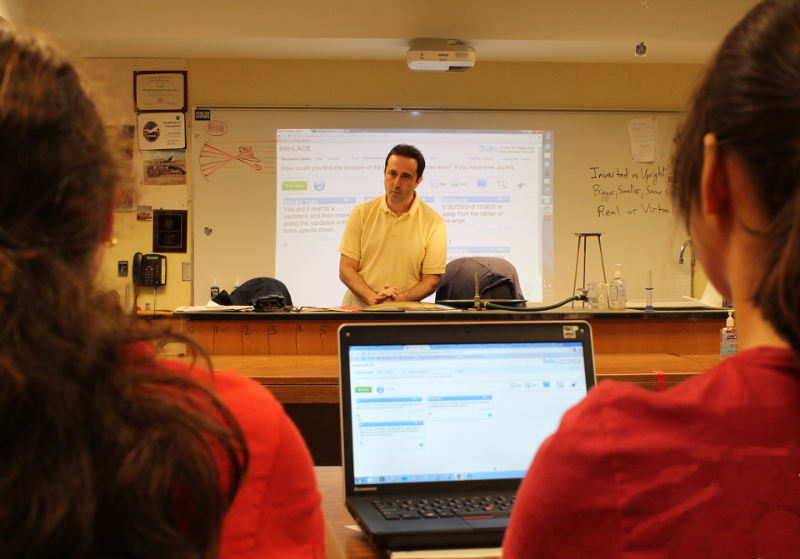The Visual Classrooms Story

It all starts at the back of a Boston area physics classroom. Tufts University researchers watched as high school students stared blankly at the lecturing teacher. The teacher was frustrated; he knew that his students didn’t get the concepts despite his amazing lectures. As we visited other classrooms, we began to see a pattern.
What started that day was more than just a technology, but a way of teaching and learning that puts student thinking at the center of discussion and enables all students to actively participate.
The Goal
Visual Classrooms began five years ago as “The InterLACE Project” at Tufts University. Supported by a four-year, $2.4M NSF grant, the project was carried out by a multidisciplinary team of learning scientists, education researchers, computer scientists, and teachers.
The ultimate goal was to make blended learning actually work. Could we leverage education research and iterative design to create technology that connected lectures, labs, homework, and group projects back into the classroom discussion? We wanted to find a way to help teachers engage all students more actively – with less lecturing and more class time for discussing, analyzing and applying the concepts they were learning.

Early Days
We started this journey at a very exciting time in education, with the intersection of two monumental changes. The research was conclusive, traditional instructional methods of lecturing and memorization were not working and classrooms needed to be more collaborative and learner centered. Second, technology was rapidly entering the learning process, enabling new ways for students and teacher to interact, both inside and outside the classroom.
Each year of the NSF project, a group of local teachers, called the “Design Team,” worked with Tufts researchers to test and improve InterLACE as it evolved from an idea into a usable product. We used their classrooms as petri dishes, to understand the effects of our technology on student learning. Regular professional development sessions allowed us to understand both why and how teachers were using the system.
 Take Visual Tour
- See how Visual Classrooms went from proof of concept to today
Take Visual Tour
- See how Visual Classrooms went from proof of concept to today
Evolution
We saw an amazing transformation in the Design Team classrooms, teachers reported that their students were more engaged with the content. They noted the ease with which they could monitor student’s time-on-task and they observed increased responsibility, sharing, and consistency of effort among students. The transparency of student behavior seemed to lessen the need for more formal assessments. Teachers were able to get real-time insights about every student’s understanding to personalize instruction and make sure no one fell through the cracks.
Student’s described how learning from the diverse ideas of peers deepened and improved their understanding. They began to communicate their thinking more clearly so their classmates could understand them. Quiet students joined class discussions in meaningful ways because they could work at their own pace.

Evaluation
In the final year of the NSF grant, our research (involving six schools, 15 classrooms, and hundreds of students) focused on how InterLACE impacted students’ conceptual understanding. Using the Physics Force Concept Inventory (FCI) as a pre/post test, students worked through a series of common InterLACE activities aimed at addressing common physics misconceptions. According to the independent Project Interim Report, May 21, 2014 by DSRA Associates, the FCI results showed that students who used InterLACE consistently outperformed a comparison group and FCI national averages. They were more aware of peers’ ideas and more likely to build on them. The study also documented advantages for teachers including extending learning beyond classroom, ease of monitoring student progress. Teachers reported that InterLACE was valuable in terms of their own productivity, record keeping and ability to focus on individual student needs, as well as encouraging student reflection, accountability, communication and improving feedback.
 Research Papers
- See the research papers from design to evaluation
Research Papers
- See the research papers from design to evaluation
Launch
Based on the successful pilots and years of research by Tufts learning scientists it became clear that InterLACE had market potential. As well, with the explosion of blended and online education and recognizing the academic challenges faced by college students and the alarming drop-out rates, demand seemed to be growing for this type of interactive learning platform.
In the summer of 2014, two of the original research team spun the technology off from Tufts as a commercial venture. We changed our name to Visual Classrooms which is shorter, more descriptive and easier to remember, and started offering the product to high schools and colleges on a student fee basis.

